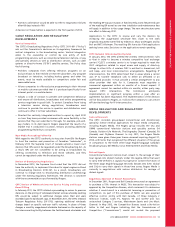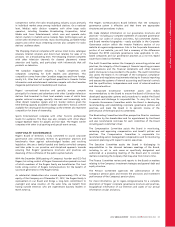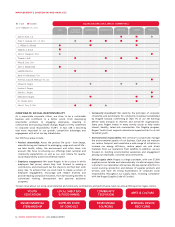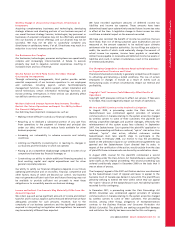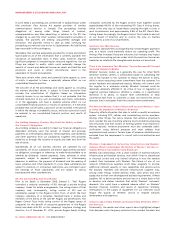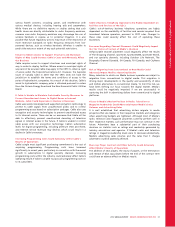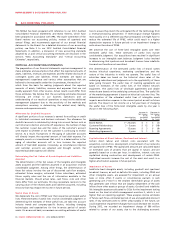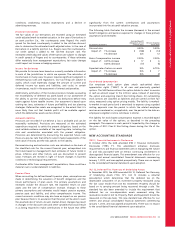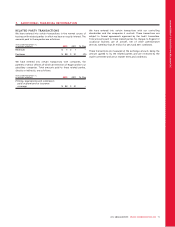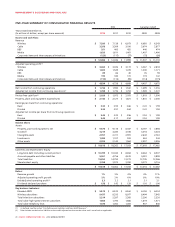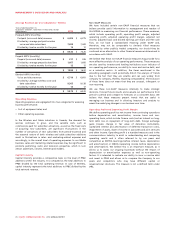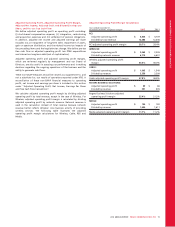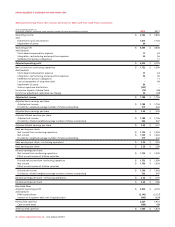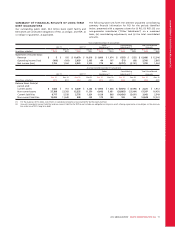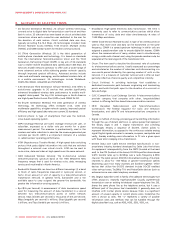Rogers 2012 Annual Report Download - page 73
Download and view the complete annual report
Please find page 73 of the 2012 Rogers annual report below. You can navigate through the pages in the report by either clicking on the pages listed below, or by using the keyword search tool below to find specific information within the annual report.
MANAGEMENT’S DISCUSSION AND ANALYSIS
conditions, weakening industry expectations and a decline in
advertising revenues.
Financial Instruments
The fair values of our Derivatives are recorded using an estimated
credit-adjusted mark-to-market valuation. In the case of Derivatives in
an asset position (i.e., the counterparty owes Rogers) the credit
spread for the bank counterparty is added to the risk-free discount
rate to determine the estimated credit-adjusted value. In the case of
Derivatives in a liability position (i.e., Rogers owes the counterparty),
our credit spread is added to the risk-free discount rate. The
estimated credit-adjusted values of Derivatives are subject to changes
in credit spreads of Rogers and its counterparties. If these estimates
differ materially from management expectations, fair value changes
could impact net income or hedging reserves.
Income Tax Estimates
We provide for income taxes based on currently available information
in each of the jurisdictions in which we operate. The calculation of
income taxes in many cases, however, requires significant judgment in
interpreting tax rules and regulations. Our tax filings are subject to
audits, which could materially change the amount of current and
deferred income tax assets and liabilities, and could, in certain
circumstances, result in the assessment of interest and penalties.
Additionally, estimation of the income provisions includes evaluating
the recoverability of deferred tax assets based on our assessment of
the ability to use the underlying future tax deductions before they
expire against future taxable income. Our assessment is based upon
existing tax laws, estimates of future profitability and tax planning
strategies. Deferred tax assets are recognized to the extent that it is
more likely than not that taxable profit will be available against
which the deferred tax assets can be utilized.
Accrued Liabilities
Provisions are recorded if we believe a loss is probable and can be
reasonably estimated. Provisions are measured at the estimated
expenditure required to settle the present obligation, based on the
most reliable evidence available at the reporting date, including the
risks and uncertainties associated with the present obligation.
Provisions are determined by discounting the expected future cash
flows at a pre-tax rate that reflects current market assessments of the
time value of money and the risks specific to the liability.
Decommissioning and restoration costs are calculated on the basis of
the identified costs for the current financial year, extrapolated into
the future based on management’s best estimates of future trends in
prices, inflation and other factors, and are discounted to present
value. Forecasts are revised in light of future changes in business
conditions or technological requirements.
If estimates differ from management’s expectations, there could be a
material over or understatement in liabilities.
Pension Plans
When accounting for defined benefit pension plans, assumptions are
made in determining the valuation of benefit obligations and the
future performance of plan assets. The primary assumptions and
estimates include the discount rate, the expected return on plan
assets and the rate of compensation increase. Changes to these
primary assumptions and estimates would impact pension expense,
pension asset and liability, and other comprehensive income. The
current economic conditions may also have an impact on our pension
plan because there is no assurance that the plan will be able to earn
the assumed rate of return. As well, market-driven changes may result
in changes in the discount rates and other variables that would result
in us being required to make contributions in the future that differ
significantly from the current contributions and assumptions
incorporated into the actuarial valuation process.
The following table illustrates the increase (decrease) in the accrued
benefit obligation and pension expense for changes in these primary
assumptions and estimates:
(In millions of dollars)
Accrued Benefit
Obligation at End
of Fiscal 2012 Pension Expense
Fiscal 2012
Discount rate 4.50% 5.50%
Impact of: 1% increase $ (188) $ (12)
1% decrease 223 12
Rate of compensation increase 3.00% 3.00%
Impact of: 0.25% increase $ 17 $ 6
0.25% decrease (17) (5)
Expected rate of return on assets N/A 6.75%
Impact of: 1% increase N/A $ 7
1% decrease N/A (7)
Stock-Based Compensation
Our employee stock option plans attach cash-settled share
appreciation rights (“SARs”) to all new and previously granted
options. The SAR feature allows the option holder to elect to receive
in cash an amount equal to the intrinsic value, instead of exercising
the option and acquiring Class B Non-Voting shares. All outstanding
stock options are classified as liabilities and are carried at their fair
value, measured using option pricing models. The liability is marked-
to-market in each period and is amortized to expense using a graded
vesting approach over the period in which the related employee
services are rendered or, as applicable, over the period to the date an
employee is eligible to retire, whichever is shorter.
The liability for stock-based compensation expense is recorded based
on the fair value of the options, as described in the preceding
paragraph. The expense in each period is impacted by the change in
the price of RCI’s Class B Non-Voting shares during the life of the
option.
NEW ACCOUNTING STANDARDS
IFRS 7, Financial Instruments: Disclosures
In October 2010, the IASB amended IFRS 7, Financial Instruments:
Disclosures (“IFRS 7”). This amendment enhances disclosure
requirements to aid financial statement users in evaluating the nature
of, and risks associated with an entity’s continuing involvement in
derecognized financial assets. This amendment was effective for our
interim and annual consolidated financial statements commencing
January 1, 2012, and was applied prospectively. There was no impact
to the consolidated financial statements upon adoption.
IAS 12, Deferred Tax: Recovery of Underlying Assets
In December 2010, the IASB amended IAS 12, Deferred Tax: Recovery
of Underlying Assets (“IAS 12”). IAS 12 includes a rebuttal
presumption which determines that the deferred tax on the
depreciable component of an investment property measured using
the fair value model from IAS 40, Investment Property should be
based on its carrying amount being recovered through a sale. The
standard has also been amended to include the requirement that
deferred tax on non-depreciable assets measured using the
revaluation model in IAS 16, Property, Plant and Equipment should be
measured on the sale basis. This new standard was effective for our
interim and annual consolidated financial statements commencing
January 1, 2012, and was applied prospectively. There was no impact
to the consolidated financial statements upon adoption.
2012 ANNUAL REPORT ROGERS COMMUNICATIONS INC. 69


